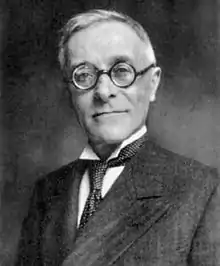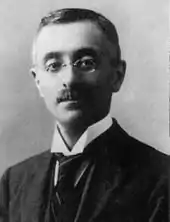Tullio Levi-Civita
Tullio Levi-Civita, ForMemRS[1] (English: /ˈtʊlioʊ ˈlɛvi ˈtʃɪvɪtə/, Italian: [ˈtulljo ˈlɛːvi ˈtʃiːvita]; 29 March 1873 – 29 December 1941) was an Italian mathematician, most famous for his work on absolute differential calculus (tensor calculus) and its applications to the theory of relativity, but who also made significant contributions in other areas. He was a pupil of Gregorio Ricci-Curbastro, the inventor of tensor calculus. His work included foundational papers in both pure and applied mathematics, celestial mechanics (notably on the three-body problem), analytic mechanics (the Levi-Civita separability conditions in the Hamilton–Jacobi equation)[2] and hydrodynamics.[3][4]
Tullio Levi-Civita | |
|---|---|
 Tullio Levi-Civita | |
| Born | 29 March 1873 |
| Died | 29 December 1941 (aged 68) Rome, Italy |
| Nationality | Italian |
| Alma mater | University of Padua |
| Known for | |
| Scientific career | |
| Fields | Mathematics |
| Institutions | University of Rome |
| Doctoral advisor | Gregorio Ricci-Curbastro |
| Doctoral students | |
Biography

Born into an Italian Jewish family in Padua, Levi-Civita was the son of Giacomo Levi-Civita, a lawyer and former senator. He graduated in 1892 from the University of Padua Faculty of Mathematics. In 1894 he earned a teaching diploma after which he was appointed to the Faculty of Science teacher's college in Pavia. In 1898 he was appointed to the Padua Chair of Rational Mechanics (left uncovered by death of Ernesto Padova) where he met and, in 1914, married Libera Trevisani, one of his pupils.[5] He remained in his position at Padua until 1918, when he was appointed to the Chair of Higher Analysis at the University of Rome; in another two years he was appointed to the Chair of Mechanics there.
In 1900 he and Ricci-Curbastro published the theory of tensors in Méthodes de calcul différentiel absolu et leurs applications,[6] which Albert Einstein used as a resource to master the tensor calculus, a critical tool in the development of the theory of general relativity. In 1917 he introduced the notion of parallel transport[7] in Riemannian geometry, motivated by the will to simplify the computation of the curvature of a Riemannian manifold.[8] Levi-Civita's series of papers on the problem of a static gravitational field were also discussed in his 1915–1917 correspondence with Einstein. The correspondence was initiated by Levi-Civita, as he found mathematical errors in Einstein's use of tensor calculus to explain the theory of relativity. Levi-Civita methodically kept all of Einstein's replies to him; and even though Einstein had not kept Levi-Civita's, the entire correspondence could be re-constructed from Levi-Civita's archive. It is evident from this that, after numerous letters, the two men had grown to respect each other. In one of the letters, regarding Levi-Civita's new work, Einstein wrote "I admire the elegance of your method of computation; it must be nice to ride through these fields upon the horse of true mathematics while the like of us have to make our way laboriously on foot". In 1933 Levi-Civita contributed to Paul Dirac's equations in quantum mechanics as well.[9]
His textbook on tensor calculus, The Absolute Differential Calculus (originally a set of lecture notes in Italian co-authored with Ricci-Curbastro), remains one of the standard texts more than a century after its first publication, with several translations available.
In 1936, receiving an invitation from Einstein, Levi-Civita traveled to Princeton, United States and lived there with him for a year. But when the risk of war in Europe again rose, he returned to Italy. The 1938 race laws enacted by the Italian Fascist government deprived Levi-Civita of his professorship and of his membership of all scientific societies. Isolated from the scientific world, he died in his apartment in Rome in 1941.
Among his PhD students were Octav Onicescu, Attilio Palatini and Gheorghe Vrânceanu.
Later on, when asked what he liked best about Italy, Einstein said "spaghetti and Levi-Civita".[10]
Other studies and honors
Analytical dynamics was another aspect of Levi-Civita's studies: many of his articles examine the three-body problem. He wrote articles on hydrodynamics and on systems of differential equations. He is credited with improvements to the Cauchy–Kowalevski theorem, on which he wrote a book in 1931. In 1933, he contributed to work on the Dirac equation. He developed the Levi-Civita field, a system of numbers that includes infinitesimal quantities.
The Royal Society awarded him the Sylvester Medal in 1922 and elected him as a foreign member in 1930. He became an honorary member of the London Mathematical Society, of the Royal Society of Edinburgh, and of the Edinburgh Mathematical Society, following his participation in their colloquium in 1930 at the University of St Andrews. He was also a member of the Accademia dei Lincei and the Pontifical Academy of Sciences.
Like Vito Volterra, being Jewish and anti-fascist, Levi-Civita was expelled from the Academy in his country as a consequence of the Italian Racial Laws.
Works
All his mathematical works, except for the monographs, the treatises and the textbooks are published in the six volumes of his "Collected works", in a revised typographical form, both amending typographical errors and author's oversights.
Articles
- Ricci, Gregorio; Levi-Civita, Tullio (1900), "Méthodes de calcul différentiel absolu et leurs applications" [Methods of the absolute differential calculus and their applications], Mathematische Annalen (in French), 54 (1–2): 125–201, doi:10.1007/BF01454201, JFM 31.0297.01, S2CID 120009332.
- Levi-Civita, Tullio (1904), "Sulla integrazione della equazione di Hamilton-Jacobi per separazione di variabili" [On the integration of the Hamilton-Jacobi equation by separation of variables], Mathematische Annalen (in Italian), 59 (3): 383–397, doi:10.1007/bf01445149, JFM 35.0362.02, S2CID 123144759.
- Levi-Civita, Tullio (1917), "Nozione di parallelismo in una varietà qualunque e conseguente specificazione geometrica della curvatura riemanniana" [Notion of parallelism in any variety and consequent geometric specification of the Riemannian curvature], Rendiconti del Circolo Matematico di Palermo (in Italian), 42: 173–205, doi:10.1007/BF03014898, JFM 46.1125.02, S2CID 122088291.
Books
- Tullio Levi-Civita and Ugo Amaldi Lezioni di meccanica razionale (Bologna: N. Zanichelli, 1923)
- Tullio Levi-Civita Questioni di meccanica classica e relativistica (Bologna, N. Zanichelli, 1924)
- Tullio Levi-Civita Lezioni di calcolo differenziale assoluto (Roma: Alberto Stock Editore 1925)
- The Absolute Differential Calculus (London & Glasgow, Blackie & Son 1927) (edited by Enrico Persico, trans. by Marjorie Long)[11]
- Tullio Levi-Civita and Enrico Persico Fondamenti di meccanica relativistica (Bologna : N. Zanichelli, 1928)
- Tullio Levi-Civita Caratteristiche dei sistemi differenziali e propagazione ondosa (Bologna, N. Zanichelli 1931)
- Tullio Levi-Civita and Ugo Amaldi Nozioni di balistica esterna (Bologna: N. Zanichelli, 1935)
- Tullio Levi Problème des N Corps en relativité générale (Gauthier-Villars, Paris, 1950, Mémorial des sciences mathématiques ISSN 0025-9187)
- Levi-Civita, Tullio (1954), Opere Matematiche. Memorie e Note [Collected mathematical works. Memoirs and notes] (PDF) (in French and Italian), Volume primo (1893−1900), Pubblicate a cura dell'Accademia Nazionale dei Lincei, Roma: Zanichelli Editore, pp. XXX, 564.
- Levi-Civita, Tullio (1956), Opere Matematiche. Memorie e Note [Collected mathematical works. Memoirs and notes] (PDF) (in French and Italian), Volume secondo (1901−1907), Pubblicate a cura dell'Accademia Nazionale dei Lincei, Roma: Zanichelli Editore, pp. VI, 636.
- Levi-Civita, Tullio (1957), Opere Matematiche. Memorie e Note [Collected mathematical works. Memoirs and notes] (PDF) (in French and Italian), Volume terzo (1908−1916), Pubblicate a cura dell'Accademia Nazionale dei Lincei, Roma: Zanichelli Editore, pp. VI, 600.
- Levi-Civita, Tullio (1960), Opere Matematiche. Memorie e Note [Collected mathematical works. Memoirs and notes] (PDF) (in French and Italian), Volume quarto (1917−1928), Pubblicate a cura dell'Accademia Nazionale dei Lincei, Roma: Zanichelli Editore, pp. VI, 608.
- Levi-Civita, Tullio (1970), Opere Matematiche. Memorie e Note [Collected mathematical works. Memoirs and notes] (in French and Italian), Volume quinto (1929−1937), Pubblicate a cura dell'Accademia Nazionale dei Lincei, Roma: Zanichelli Editore, pp. VI, 670.
- Levi-Civita, Tullio (1970), Opere Matematiche. Memorie e Note [Collected mathematical works. Memoirs and notes] (in French and Italian), Volume sesto (1938−1941), Pubblicate a cura dell'Accademia Nazionale dei Lincei, Roma: Zanichelli Editore, pp. VI, 502.
- Levi-Civita, Tullio (2007) [1895], Pamphlets, mathematics, University of Michigan, retrieved 14 January 2017. A collection of some of his published papers (in their original typographical form), probably an unordered uncorrected collection of offprints.
See also
Notes
- Tullio Levi-Civita. Nndb.com. Retrieved on 2011-08-14.
- (Levi-Civita 1904)
- O'Connor, John J.; Robertson, Edmund F., "Tullio Levi-Civita", MacTutor History of Mathematics archive, University of St Andrews.
- Tullio Levi-Civita at the Mathematics Genealogy Project
- Goodstein, Judith R. (2018). Einstein's Italian mathematicians : Ricci, Levi-Civita, and the birth of general relativity. American Mathematical Society. pp. 115–117. ISBN 978-1470428464.
- (Ricci & Levi-Civita 1900).
- (Levi-Civita 1917)
- Iurato, Giuseppe (2016). "On the history of Levi-Civita's parallel transport". arXiv:1608.04986. Bibcode:2016arXiv160804986I. Cite journal requires
|journal=(help) - C Cattani and M De Maria, Geniality and rigor: the Einstein – Levi-Civita correspondence (1915–1917), Riv. Stor. Sci. (2) 4 (1) (1996), 1–22; as cited in MacTutor archive.
- Jackson, Allyn (1996). "Celebrating the 100th Annual Meeting of the AMS". In Case, Bettye Anne (ed.). A Century of Mathematical Meetings. Providence, RI: American Mathematical Society. pp. 10–18. ISBN 0-8218-0465-0.
- Rainich, G. Y. (1928). "Levi-Civita on Tensor Calculus" (PDF). Bull. Amer. Math. Soc. 34: 775–777. doi:10.1090/s0002-9904-1928-04644-x.
References
Biographical references
- "Professor T. Levi-Civita, Member of Vatican Academy," The Jewish Chronicle (UK), February 6, 1942.
General references
- Segre, Beniamino (1975), "Parole introduttive al Convegno", in Segre, Beniamino; Cattaneo, Carlo; Bompiani, Enrico; Colombo, Giuseppe; Finzi, Bruno; Graffi, Dario; Radicati di Brozolo, Luigi; Tricomi, Francesco Giacomo (eds.), Tullio Levi-Civita. Convegno internazionale celebrativo del centenario della nascita (Roma, 17–19 dicembre 1973) [Tullio Levi-Civita. International congress for the celebration of the centenary of his birth (Rome, 17–19 December 1973)], Atti dei Convegni Lincei (in Italian), 8, Roma: Accademia Nazionale dei Lincei, pp. 171–177, ISSN 0391-805X. The "Inaugural address" (English translation of the contribution title) of Beniamino Segre, a commemoration describing briefly many aspects of the life and the work of Levi-Civita.
Scientific references
- Aczel, Amir D. (1999), God's Equation, New York: MJF Books, pp. 236, ISBN 1-56858-139-4.
- Graffi, Dario (1975), "L'Elettromagnetismo in Levi-Civita", in Segre, Beniamino; Cattaneo, Carlo; Bompiani, Enrico; Colombo, Giuseppe; Finzi, Bruno; Graffi, Dario; Radicati di Brozolo, Luigi; Tricomi, Francesco Giacomo (eds.), Tullio Levi-Civita. Convegno internazionale celebrativo del centenario della nascita (Roma, 17–19 dicembre 1973) [Tullio Levi-Civita. International congress for the celebration of the centenary of his birth (Rome, 17–19 December 1973)], Atti dei Convegni Lincei (in Italian), 8, Roma: Accademia Nazionale dei Lincei, pp. 171–177, ISSN 0391-805X. "Electromagnetism in the work of Levi-Civita" (English translation of the contribution title) is a survey of some of the works of Levi-Civita on the theory of electromagnetism.
- Loinger, Angelo (2007). "Einstein, Levi-Civita, and Bianchi relations". arXiv:physics/0702244..
Publications dedicated to his memory
- Segre, Beniamino; Cattaneo, Carlo; Bompiani, Enrico; Colombo, Giuseppe; Finzi, Bruno; Graffi, Dario; Radicati di Brozolo, Luigi; Tricomi, Francesco Giacomo, eds. (1975), Tullio Levi-Civita. Convegno internazionale celebrativo del centenario della nascita (Roma, 17–19 dicembre 1973) [Tullio Levi-Civita. International congress for the celebration of the centenary of his birth (Rome, 17–19 December 1973)], Atti dei Convegni Lincei (in English, French, Italian, and Russian), 8, Roma: Accademia Nazionale dei Lincei, p. 316, ISSN 0391-805X.
External links
 Media related to Tullio Levi-Civita at Wikimedia Commons
Media related to Tullio Levi-Civita at Wikimedia Commons- Tullio Levi-Civita at the Mathematics Genealogy Project
- Scienceworld biography
- Another short biography
- An Italian short biography of Tullio Levi-Civita in Edizione Nazionale Mathematica Italiana online.